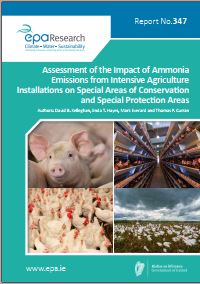Research 347: Assessment of the Impact of Ammonia Emissions from Intensive Agriculture Installations on Special Areas of Conservation and Special Protection Areas
Authors: David B. Kelleghan, Enda T. Hayes, Mark Everard and Thomas P. Curran
Summary: Atmospheric ammonia poses a significant threat to biodiversity and human health. Concentrations of ammonia in the air downwind of hotspot sources, such as pig and poultry farms, are likely to negatively affect the environment. This project quantified and assessed the impact of ammonia emissions from intensive pig and poultry units in Ireland by monitoring detailed ammonia emissions from 17 animal production houses across four farms.

Environment and Health :: Environmental Protection Agency, Ireland
https://www.epa.ie/media/epa-2020/publications/research/Thumbnail_347.jpg